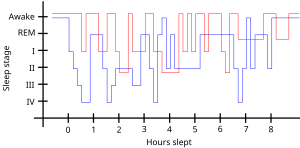Restless legs syndrome
| Restless legs syndrome | |
|---|---|
| Synonyms | Willis-Ekbom disease (WED), Wittmaack-Ekbom syndrome |
 |
|
| Sleep pattern of a person with restless legs syndrome (red) versus a healthy sleep pattern (blue). | |
| Classification and external resources | |
| Specialty | Sleep medicine |
| ICD-10 | G25.8 |
| ICD-9-CM | 333.94 |
| OMIM | 102300 608831 |
| DiseasesDB | 29476 |
| MedlinePlus | 000807 |
| eMedicine | neuro/509 |
| Patient UK | Restless legs syndrome |
| MeSH | D012148 |
Restless legs syndrome (RLS) is a disorder that causes a strong urge to move one's legs. There is often an unpleasant feeling in the legs that improves somewhat with moving them. Occasionally the arms may also be affected. The feelings generally happen when at rest and therefore can make it hard to sleep. Due to the disturbance in sleep people with RLS may have daytime sleepiness, low energy, irritability, and a depressed mood. Additionally, many have limb twitching during sleep.
Risk factors for RLS include low iron levels, kidney failure, Parkinson's disease, diabetes mellitus, rheumatoid arthritis, and pregnancy. A number of medications may also trigger the disorder including antidepressants, antipsychotics, antihistamines, and calcium channel blockers. There are two main types. One is early onset RLS which starts before age 45, runs in families and worsens over time. The other is late onset RLS which begins after age 45, starts suddenly, and does not worsen. Diagnosis is generally based on a person's symptoms after ruling out other potential causes.
Restless leg syndrome may resolve if the underlying problem is addressed. Otherwise treatment includes lifestyle changes and medication. Lifestyle changes that may help include stopping alcohol and tobacco, and sleep hygiene. Medications used include levodopa or a dopamine agonist such as pramipexole. RLS affects an estimated 2.5–15% of the American population. Females are more commonly affected than males and it becomes more common with age.
RLS sensations range from pain or an aching in the muscles, to "an itch you can't scratch", a "buzzing sensation", an unpleasant "tickle that won't stop", a "crawling" feeling, or limbs jerking while awake. The sensations typically begin or intensify during quiet wakefulness, such as when relaxing, reading, studying, or trying to sleep.
...
Wikipedia
